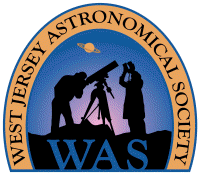SJAstro Page Index
| Weather Links |
Mercury 2021 last
sighting November 3 |
Lunar X |
Comet 67P/Churyumov-Gerasimenko
October 18, 2021
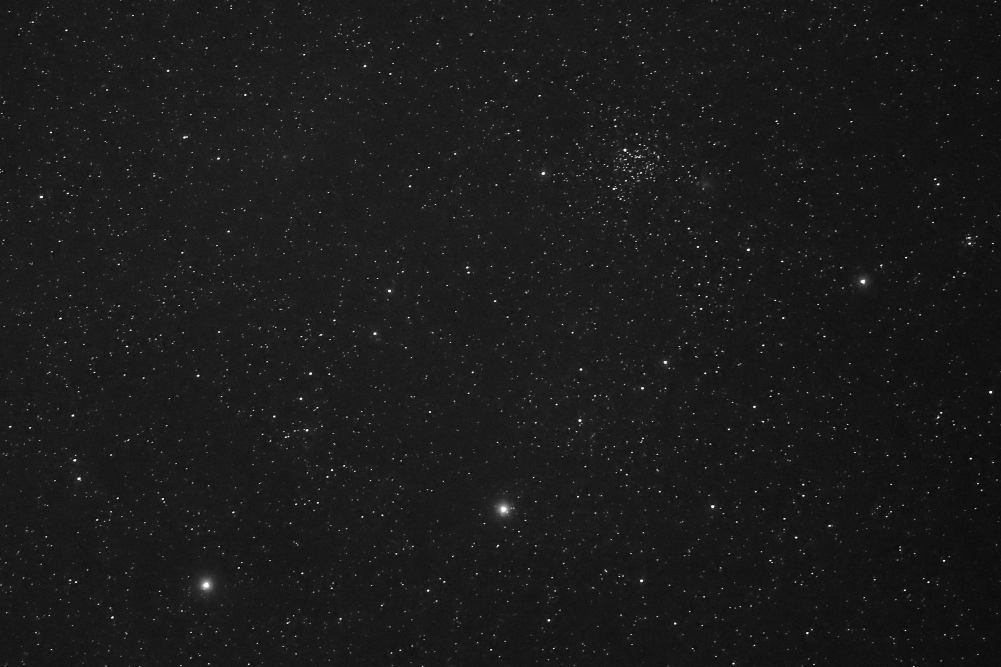
|
The image above shows the field around the foot of Castor, one of the
Gemini twins. It was
captured on
October 18, 2021, from Wharton State Forest,
NJ. It
was taken at 5:10 am EDT with a Canon EOS
RP mirrorless digital camera and a Canon 200 mm f/2.8L lens on a
fixed tripod. It's a single
raw frame manually exposed 2 seconds at f/2.8, ISO 12,800. It
was cropped to 58% of the original linear dimensions (for a
filed 6░ wide x 4░ high), converted to monochrome, the
brightness and contrast were lightly adjusted and then saved as a JPEG with Canon's Digital Photo Professional 4. Mouseover for labels.
The triangular shape near 67P is simply for reference in the
close-up image below.
The most prominent object is the open cluster, Messier 35 (M35),
but the primary objective was comet
67P/Churyumov-Gerasimenko, about 2░ ENE of M35.
I had observed 67P visually the previous morning, October 17,
with my 88 mm apo spotting scope from the same site. Although it
was only about magnitude 10.5, I saw not just the coma, which I
estimated at 2 arc minutes diameter, but
also a tail,
about 10 arc minutes long. It was faint, but clearly there in
the very position indicated by my SkyTools chart (I didn't refer
to the detailed chart until after I established an exact
position). Afterwards, I swung to Hassaleh (Iota Aur) and
observed nearby comet
29P/Schwassmann-Wachmann. It too was nominally magnitude
10.5, but it was just an amorphous glow at the limit of
visibility. I had seen 29P more easily about a week earlier with
my 16-inch dob at Belleplain State Forest, NJ. As the moon and
weather permit, I'm anxious to get the 16-inch on 67P.
The image below is from the same raw frame with the same
adjustments, except it was cropped to 13% of the original linear
dimensions
for a field 1.3░ wide x 0.9░ high to better show the comet,
albeit, very dimly. Mouseover for labels. |
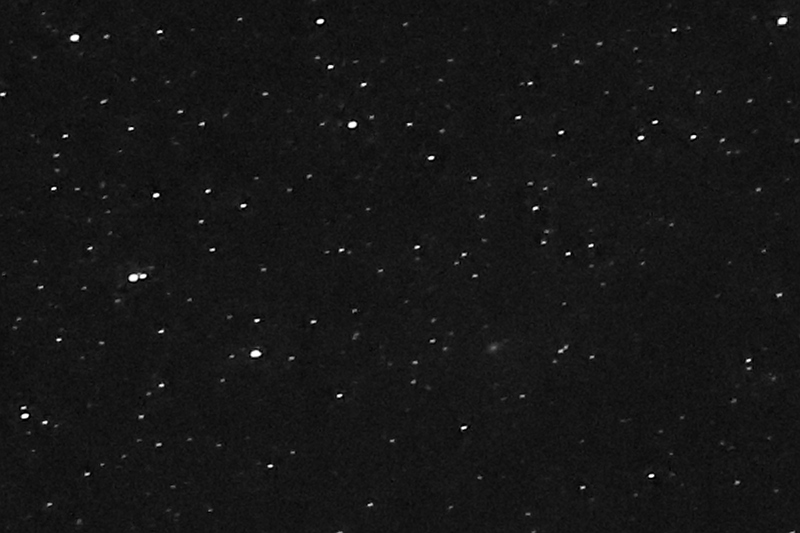
Jupiter and Saturn in Capricornus
September 26, 2021
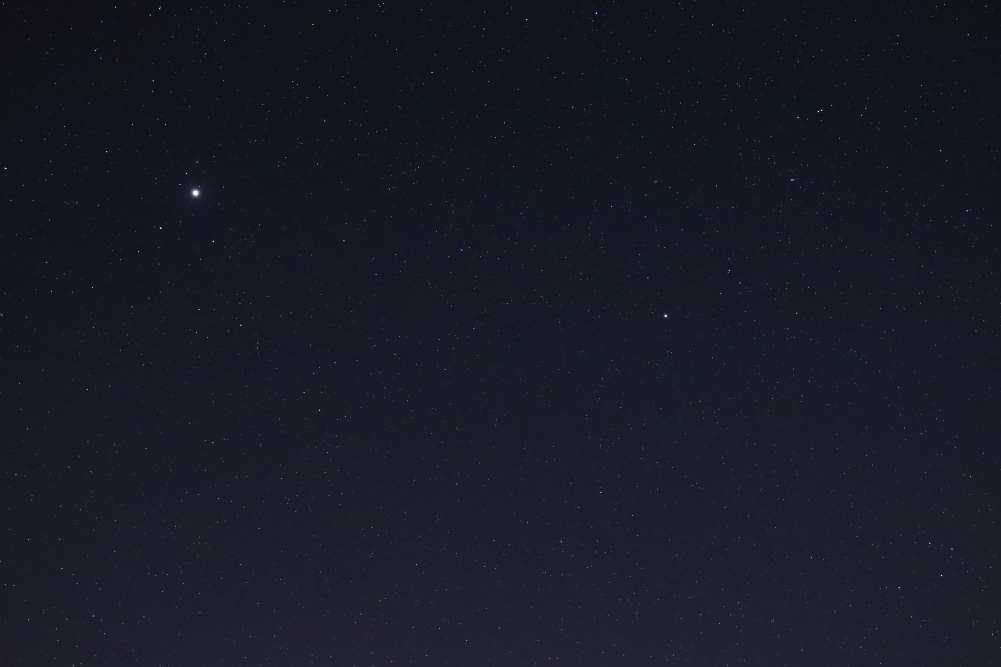
|
Jupiter and
Saturn were both
in the constellation
Capricornus the Goat when this image of them was
captured on
September 26, 2021, from Wharton State Forest,
NJ. These two planets were in close conjunction on December 21,
2020, when they were just a tenth of a degree apart. In this
view, they're 16░ apart. Both are in retrograde (westward)
motion following solar opposition on August 1 (Saturn) and
August 19 (Jupiter). They will be stationary on October 10 and October 18
respectively when direct (eastward) motion resumes. The
span between them will then grow as Jupiter moves eastward faster
than Saturn.
Mouseover for labels.
Taken at 9:38 pm EDT with a Canon EOS
RP mirrorless digital camera (on a fixed tripod) and a Sigma 50
mm f/1.4 Art lens. It's a single
raw frame manually exposed 2 seconds at f/2.0, ISO 6400
and 3800 K white balance.
It was cropped to 80% of the original linear dimensions
for a field 32░ wide x 22░ high,
then
converted to a JPEG, with Canon's Digital Photo Professional 4. No other adjustments were made. |
Alpha and Beta Capricorni...
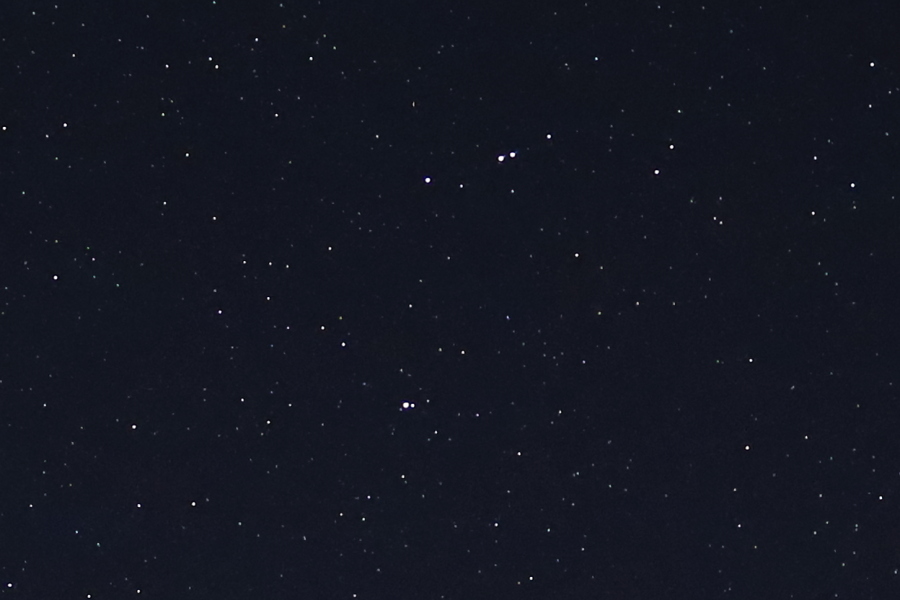
|
This view comes from the same raw image as the one above, but is cropped to 20% of
the original linear dimensions for a field 5.1░ wide x 3.4░
high and centered on the upper-right-hand (western)
tip of the
Capricornus "bikini bottom" stick figure. It
shows a pair of wide-spaced double stars that are easily
resolved in binoculars. One of them,
Algedi, is a moderate challenge for unaided eyes with
magnitude 3.6 and 4.3 stars separated by about 3.4 arc minutes.
The other, Dabih, would be a
considerable challenge for unaided eyes since the magnitude 3.1
primary has a magnitude 6.2 secondary separated by 3.1 arc
minutes; the brightness of the secondary is at the threshold of
normal human vision from a dark site (even when it's not next to a
companion three magnitude brighter). Mouseover for labels. |
Jupiter with Deneb Algedi and Nashira...
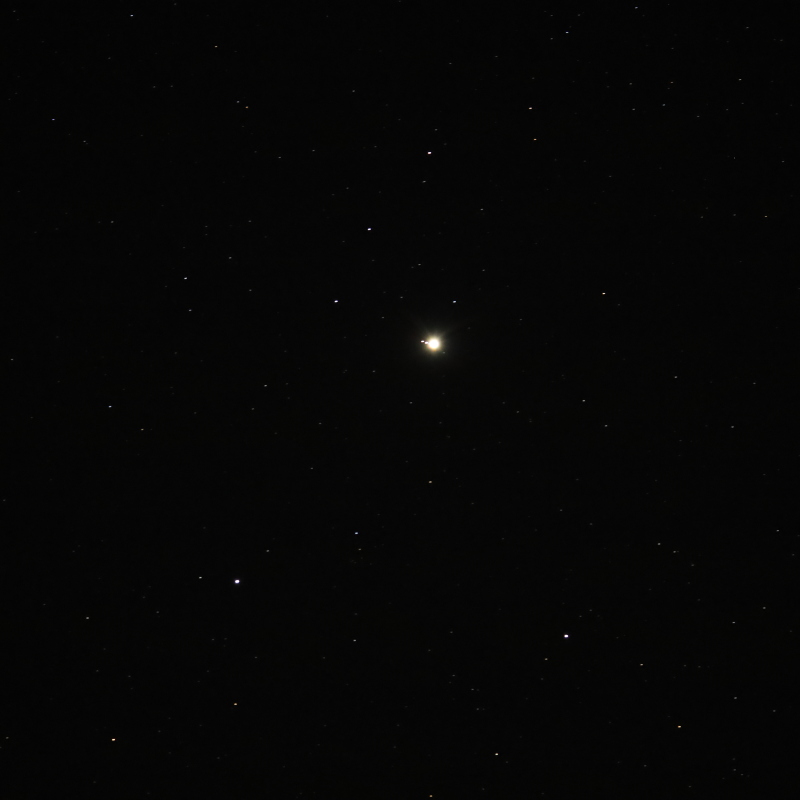
|
Jupiter was at the
upper-left-hand (eastern) tip of the Capricornus stick figure when this image of them was
captured on
September 26, 2021, from Wharton State Forest,
NJ. The field here is similar to that which would be seen in
ordinary binoculars, which provide a lovely view of this current
scene. Depending on the ever-changing positions of Jupiter's
Galilean satellites, they are often visible when the binoculars
are held steady (a couple of the satellites are visible here).
Mouseover for labels.
Taken at 9:51 pm EDT with a Canon EOS
RP mirrorless digital camera and a Tamron 150 to 600 mm
f/5.6-6.3 zoom lens set to 300 mm focal length. It's a single
raw frame manually exposed 2.5 seconds at f/5.6, ISO 6400.
It was cropped to 61 x 91% of the original linear dimensions
for a field 4.2░ square, set to daylight
white balance (color saturation increased to +4)
then
converted to a JPEG, all with Canon's Digital Photo Professional 4. No other adjustments were made. |
Recurrent Nova RS Ophiuchi
August 12, 2021
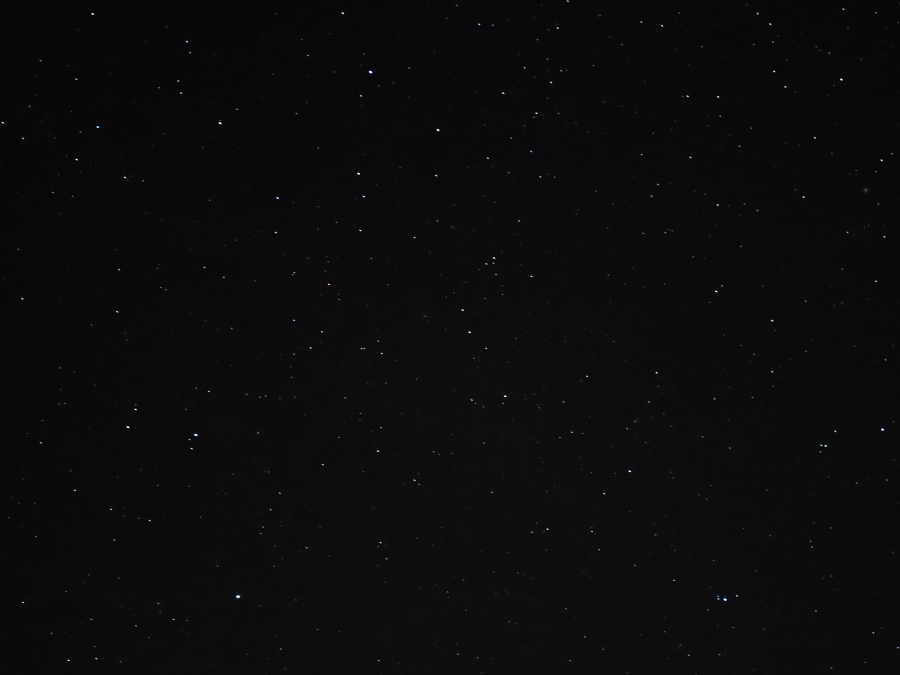
|
The recurrent nova, RS Ophiuchi,
was captured on
August 12, 2021, from the
West Jersey
Astronomical Society's Barnegat Road Observing Site in the
New Jersey Pinelands. On August 8, 2021, Irish
amateur astronomer Keith Geary was the first to notice a sharp increase in its brightness from magnitude 11 to
magnitude 5. RS Oph ultimately reached magnitude 4.5, bright
enough to see with unaided eyes. Here's a
Bob King article at Sky & Telescope online.
I observed it with 8x42 binoculars from home on
August 9, 2021,
with 8x42 binoculars and I estimated it was about magnitude 4.6,
but the hazy, light-polluted suburban skies precluded any
sighting with unaided eyes. The first opportunity for me to see
it under a clear dark sky was on August 12 at Barnegat, but it
had faded significantly
by then. It was easy to see with the 8x42s and I estimated it to
be about magnitude 6.2, too faint for my unaided eyes.
Current magnitude estimates are available at AAVSO.
On September 10, I estimated magnitude 9.1 using my 16-inch
Newtonian telescope, in which it looked reddish.
I observed RS Oph again on October
2, from the WAS Barnegat Road Observing
Site in the dark NJ Pines. Using my 88 mm apo spotting scope at
40x, I estimated it was magnitude 9.8. Contemporaneous estimates
at AAVSO were also running about magnitude 9.8.
This snapshot was taken at 10:26 pm EDT on
August 12 with a Canon EOS RP mirrorless digital camera
and a Canon 100 mm, f/2.8L macro lens on a fixed tripod. This is a single
raw
frame exposed 4 seconds at f/2.8, ISO 6400
and 4200K white balance. It was minimally processed with
Canon's Digital Photo Professional 4; shoadow intensity reduced
by 4 of 5 steps and color saturation was increased
by 4 of 4 steps. It was cropped to a 4:3 ratio (50 x 56% of the of the
original dimensions) for a field 10.3░ wide x 7.7░ high
(similar to the 9.1░ field of the 8x42s).
Mouseover for labels.
Note: I posted this image on October 5,
2021, replacing the previous image which had been taken a
few minutes late with the same equipment and settings, except
using a diffusion filter which puffs up the stars making the
brightness and color differences more apparent, but causing
fainter stars to fade away.
Here's
the previous diffuser version.
The graph below is a light curve of RS Oph
from AAVSO
(visual estimates with a smoothed mean), generated at noon EDT on
August 17, 2021. |
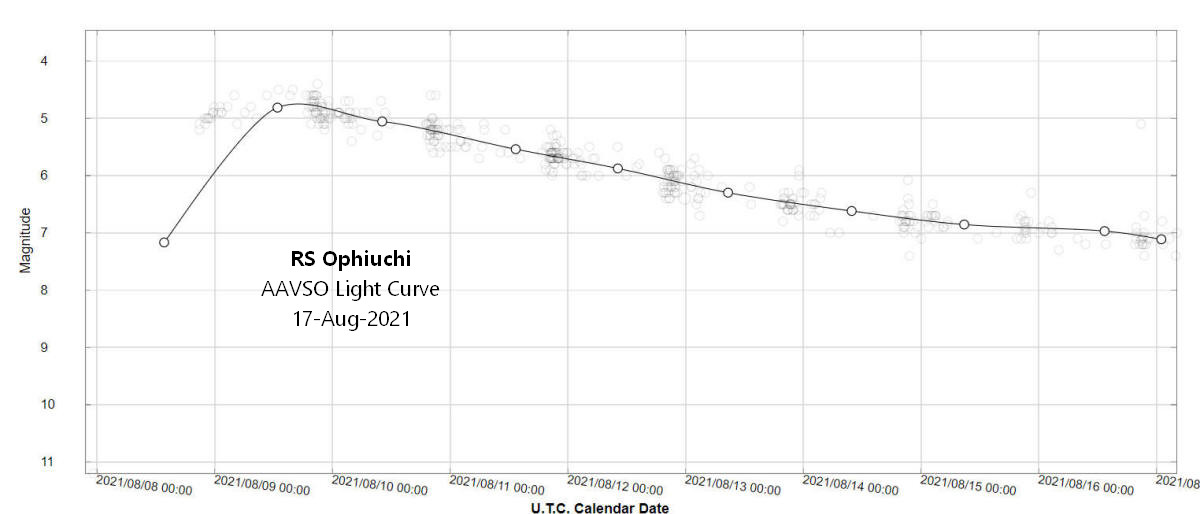
The Smoke-Enshrouded Sun & Moon
July 20-21, 2021
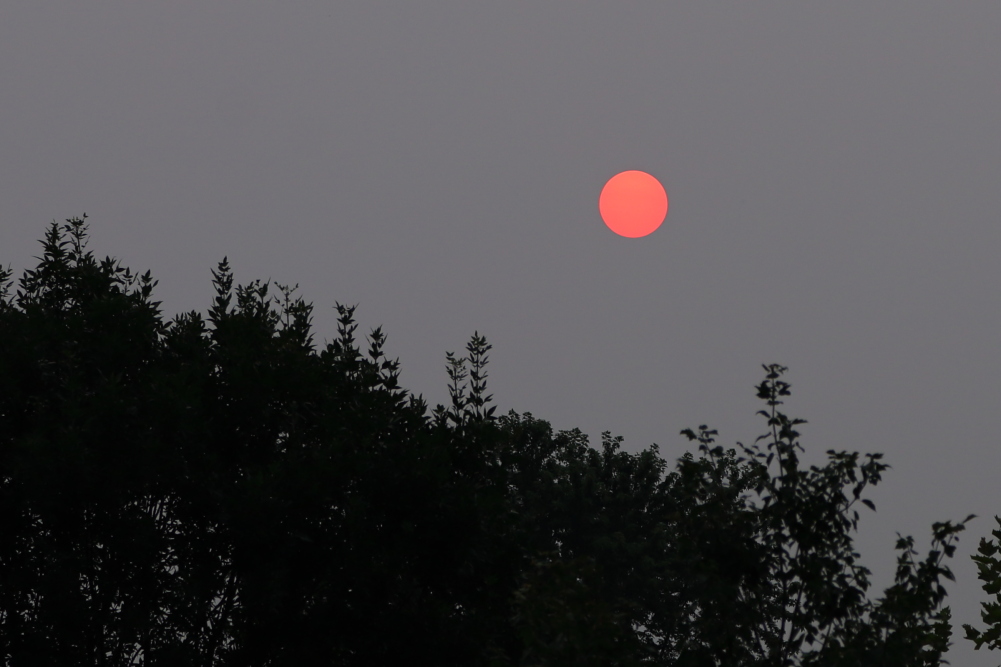
|
The brightness of the Sun was
considerably weakened and reddened by smoke from distant forest
fires on
July 20, 2021, when this snapshot of it was
captured without a filter at 7:40 pm EDT, 44 minutes before
sunset at 8:24 pm, from Collins Lane Park
in Maple Shade, NJ.
Taken with a Canon EOS
RP mirrorless digital camera and a Canon 24 to 105 mm, f/4.0L
zoom lens set to 105 mm focal length. It's a single
handheld
raw frame automatically exposed (minus one stop) 1/250 second at f/5.6, ISO 100
and daylight white balance.
It was mildly adjusted in Canon's Digital Photo Professional 4
and cropped to a 38% of the of the original dimensions
for a field 7.5░ wide x
5.0░ high. At the time of the picture, the Sun was at 7.1░
altitude. |
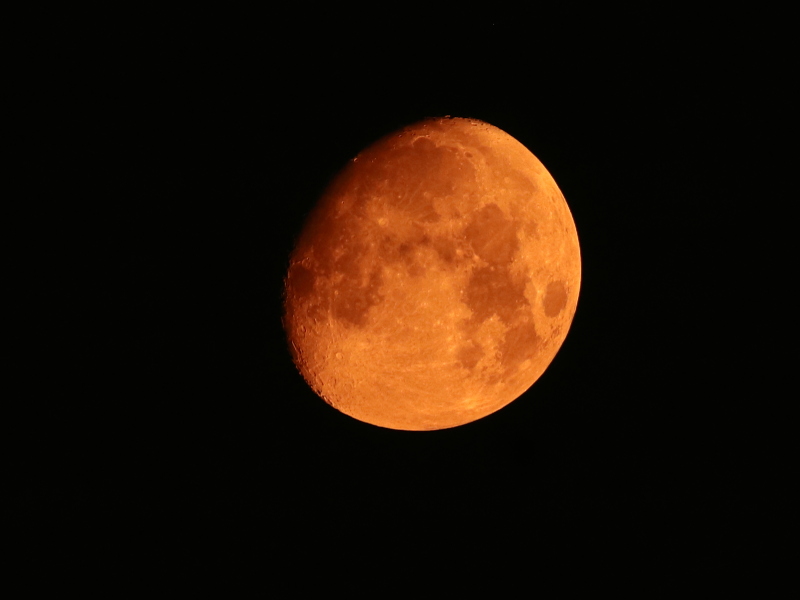
|
Overnight, the Waxing Gibbous Moon was
also affected by the hazy smoke and visually, it displayed an
amber color. This image was captured on
July 21, 2021, at 1:14 am EDT from the railroad
tracks
in Maple Shade, NJ.
At the time, it was 89% illuminated and 13.2░ altitude in the
constellation Ophiuchus. Taken with a Canon EOS RP mirrorless
digital camera and a Canon 400 mm, f/5.6L telephoto lens on a
fixed tripod. It's a single raw frame automatically exposed
(minus three stops) 1/6 second at f/8.0, ISO 1600
and daylight white balance.
It was mildly adjusted in Canon's Digital Photo Professional 4
and cropped to a 4:3 ratio (26% x 29% of the of the original dimensions)
for a field 1.3░ wide x
1.0░ high.
The orange moon as shown was captured with daylight white
balance. I tried adjusting it to tungsten white balance in
Canon's DPP 4, but the moon was still an amber color. I then
dropped the color temperature to its minimum 2000 K setting and
a rosy cast remained. Finally, I used the monochrome setting
(converted to a grayscale)
and it produced the fairly normal view shown on mouseover.
Click the image for a enlargement of the monochrome version (cropped
to 12% wide x
18% high = 0.62░ square).
Although dimmer than usual, the moon was still obvious
to unaided eyes at 1:15 am, as was the planet Jupiter. After
locating it with 10x42 binoculars, I was able to spot the planet
Saturn with unaided eyes. Overhead, the normally bright star
Vega could be seen with unaided eyes. That was it. |
Mars,
Venus and the Crescent Moon
July 11, 2021
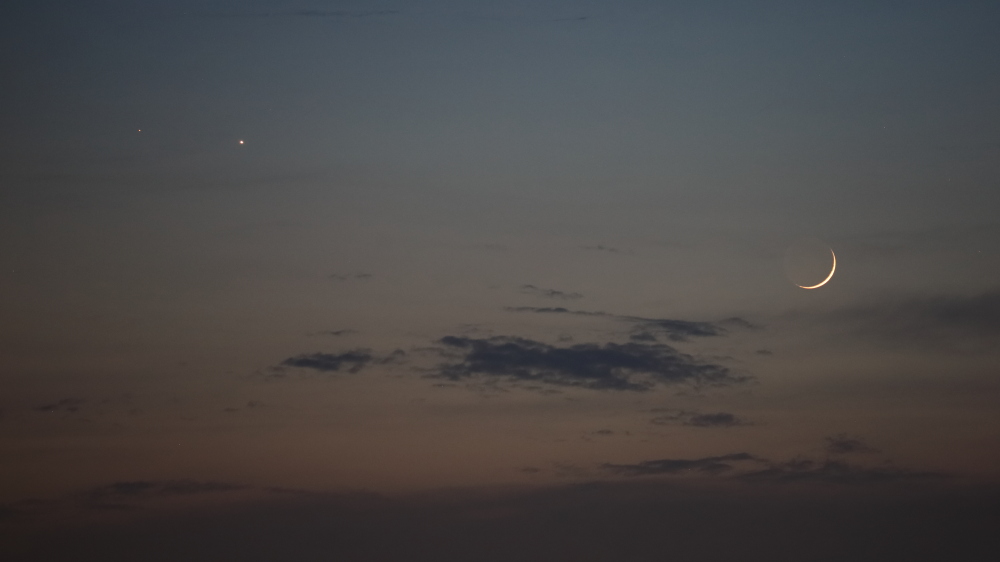
|
The planets Mars and
Venus were joined by the young
Crescent Moon on
July 11, 2021. When this image of them was
captured at 9:15 pm EDT from Swede Run in Moorestown, NJ, Mars
and Venus were 1.0░ apart, while the two-day-old, 4.0%
illuminated Moon was 5.8░ northwest of Venus. Note the delicate
earthshine on the non-crescent area of the Moon. Despite l haze
and some scattered clouds, Venus and the Moon were easy to
see with unaided eyes around the middle of twilight, but Mars
was not seen, and they slipped into the cloud mass below them
before binoculars could be utilized. At the same time on the
evening of July 12, the span between Mars and Venus will have
shrunk to half a degree, while the Moon will have moved to a
position about 7░ above-left of the planetary pair.
This snapshot was taken with a Canon EOS
RP mirrorless digital camera and a Tamron 150 to 600 mm, f/5.0
to 6.3 telephoto lens on a fixed tripod, set to 188 mm focal
length. It's a single raw frame exposed 1/2 second at f/5.0, ISO 1600.
It was mildly adjusted in Canon's Digital Photo Professional 4
and cropped to a 16:9 ratio, 92% of the width x 78% of the
height, for a field
10.0░ wide x
5.7░ high. At the time of the picture, the Moon was at 7.8░
altitude, Venus was at 8.9░ altitude
and Mars was at 9.0░ altitude. Mouseover for labels. |
Mars and
Venus
July 7, 2021
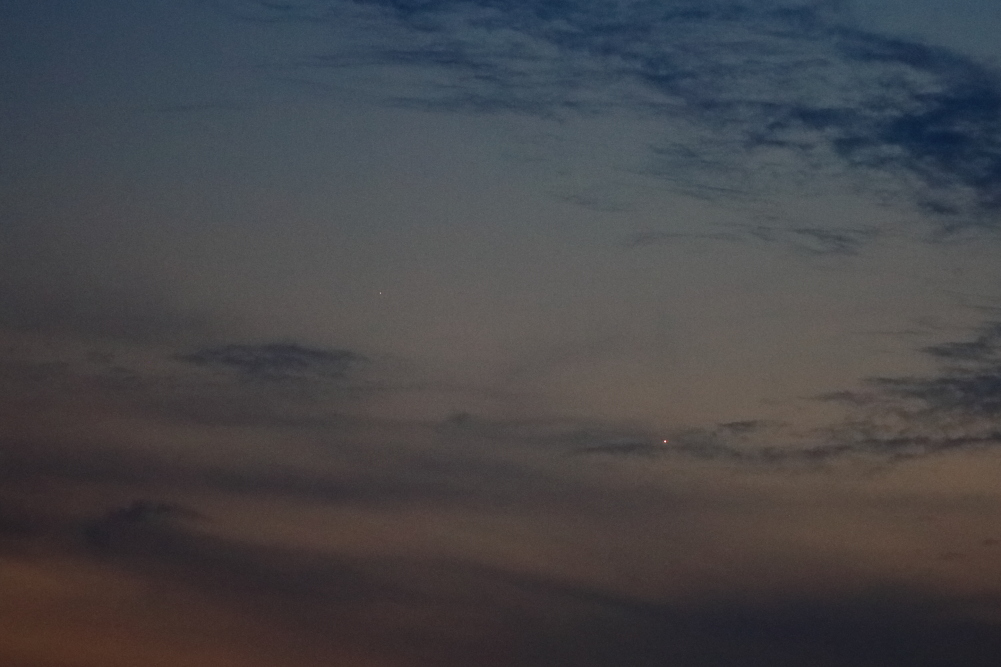
|
The earth's two closest planetary neighbors,
Mars and
Venus, were observed from Collins Lane Park in Maple
Shade, NJ, on
July 7, 2021. Despite less-than-ideal sky
conditions (it was hazy to cloudy in their direction to the
northwest), brilliant Venus, magnitude -3.9, was easy to see
with unaided eyes (until it slipped behind the clouds), but
Mars, about 200x dimmer at magnitude +1.8, required binoculars
(I used a pair of 8x42s). As seen here, they're about 3╝░apart.
On the evenings of June 12 & 13, the pair will be little more
than a half degree apart as Venus passes Mars. Currently, Venus
is moving eastward about twice as fast as Mars, 1.2░/day vs.
0.6░/day respectively. Since the sun is now moving eastward at
about 0.95░/day, Venus' elongation from the sun is increasing
while Mars' is decreasing. The thin crescent moon will join them
on July 11 & 12.
This snapshot was
taken at 9:11 pm EDT with a Canon EOS
RP mirrorless digital camera and a Canon 100 mm, f/2.8L
macro telephoto lens on a fixed tripod. It's a single raw frame
exposed 1/10 second at f/2.8, ISO 1600.
It was adjusted in Canon's Digital Photo Professional 4
and cropped to 50% of its original linear dimensions for a field
10.3░ wide x
6.9░ high. At the time of the picture, Venus was 9.9░ altitude
and Mars was 11.3░ altitude. Mouseover for labels. |
Mercury
July 5, 2021
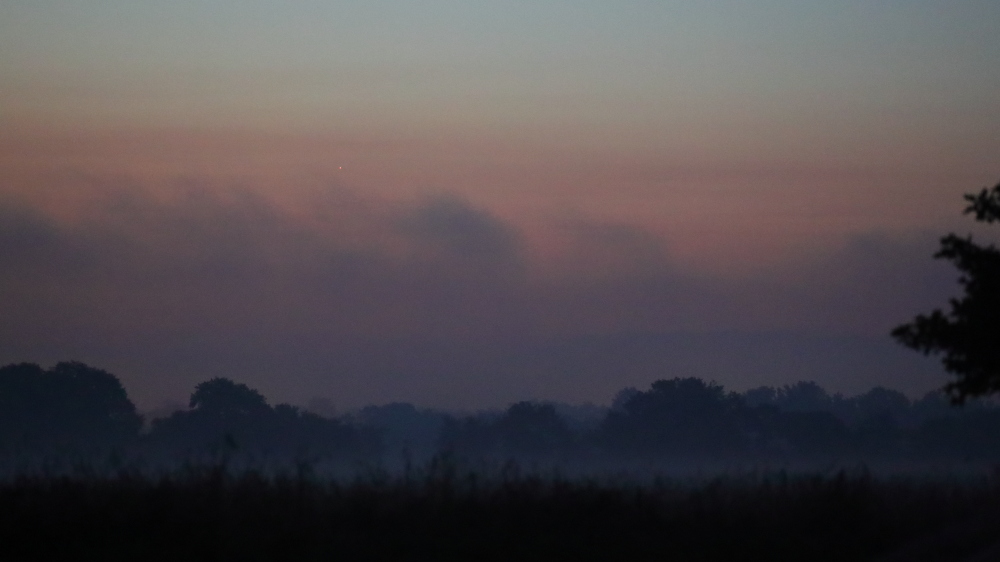
|
The innermost planet of the solar system,
Mercury, was spotted at 4:35 am EDT on
July 5, 2021, as it emerged from a veil of fog &
haze along the eastern horizon at Laurel Run Park in Delran, NJ.
Mercury was at greatest western elongation the day before, July
4, and this was the second sighting this elongation, the
67th
elongation in a row that I've spotted Mercury. This snapshot was
taken two minutes later, at 4:37 am, with a Canon EOS
RP mirrorless digital camera and a Canon 200 mm, f/2.8L
telephoto lens on a fixed tripod. It's a single raw frame
exposed 1/13 second at f/2.8, ISO 12,800.
It was lightly adjusted in Canon's Digital Photo Professional 4
and cropped to a 16:9 ratio, 95% of its original width and 80%
of the height for a field
9.8░ wide x
5.5░ high. At the time of the picture, Mercury was 3.2░ altitude
and magnitude +0.4. Mouseover for a label. |
Click here
for the previous page.
Click here
for an index to all previous SJAstro pages.












